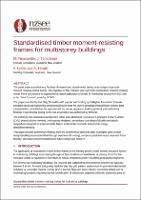| dc.contributor.author | Tombleson, Jack | |
| dc.contributor.author | Newcombe, Michael | |
| dc.contributor.author | Leslie, Sam | |
| dc.contributor.author | Hewitt, Andrew | |
| dc.date.accessioned | 2024-07-01T02:01:18Z | |
| dc.date.available | 2024-07-01T02:01:18Z | |
| dc.date.issued | 2024-04-09 | |
| dc.identifier.uri | https://repo.nzsee.org.nz/xmlui/handle/nzsee/2739 | |
| dc.description.abstract | The paper presents preliminary findings from an extensive experimental testing campaign (Project Skyscraper) performed on full-scale moment-resisting timber frames intended for application in multistorey buildings.
The project was led by Red Stag Timberlab, supported/funded by Callaghan Innovation, experimental testing was performed at BRANZ and Enovate provided structural engineering design and consulting. The objective of this research was to provide standardized moment-resisting timber frame connections to support the increased application of timber in multistorey structures in NZ (akin to the ‘Steel Connect’ guide by SCNZ).
The project involved the design, fabrication, and testing of a range of Glulam and LVL internal beam-column joint sub-assemblies. These subassemblies incorporate steel plastic hinges/fuses to allow for ductile response, energy dissipation/damping and to suppress brittle failure modes (capacity design). This paper presents the preliminary findings from the project to-date and highlights some critical issues that require further investigation/consideration including premature column fracture due to bursting stresses (in epoxied rod connections), and predicted versus actual frame flexibility. | |
| dc.language.iso | en | |
| dc.publisher | New Zealand Society for Earthquake Engineering | |
| dc.relation.ispartofseries | 2024;41 | |
| dc.subject | Seismic performance, risk mitigation and resilience of new and existing structures | |
| dc.title | Standardised timber moment-resisting frames for multistorey buildings | |
| dc.type | Article | |

